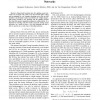592 search results - page 29 / 119 » Learning Generalized Plans Using Abstract Counting |
IJCNN
2006
IEEE
14 years 2 months ago
2006
IEEE
Abstract— Supervised learning rules for spiking neural networks are currently only able to use time-to-first-spike coding and are plagued by very irregular learning curves due t...
TROB
2008
13 years 8 months ago
2008
Affordances encode relationships between actions, objects and effects. They play an important role on basic cognitive capabilities such as prediction and planning. We address the p...
CVIU
2006
13 years 8 months ago
2006
In this paper we develop a system for human behaviour recognition in video sequences. Human behaviour is modelled as a stochastic sequence of actions. Actions are described by a f...
SIGCSE
2009
ACM
14 years 9 months ago
2009
ACM
ion and Extensibility in Digital Logic Simulation Software Richard M. Salter and John L. Donaldson Computer Science Department Oberlin College Oberlin, OH 44074 rms@cs.oberlin.edu,...
PERCOM
2004
ACM
14 years 8 months ago
2004
ACM
A course on pervasive computing should be structured around key functions throughout a systems development process to cover common underlying concerns throughout science and engin...

